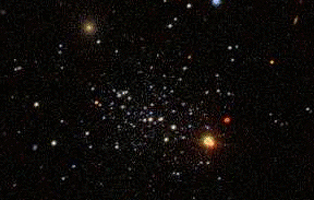A team led by a Yale University astronomer has discovered the least luminous, most dark matter-filled galaxy known to exist.
The galaxy, called Segue 1, is one of about 12 small satellite galaxies orbiting our own Milky Way Galaxy. The ultra-faint galaxy is a billion times less bright than the Milky Way, according to the team’s results, to be published in an upcoming issue of The Astrophysical Journal. But despite its small number of visible stars, Segue 1 is nearly a thousand times more massive than it appears, meaning most of its mass must come from dark matter.
“I’m excited about this object,” says Marla Geha, an assistant professor of astronomy at Yale and the paper’s lead author. “Segue 1 is the most extreme example of a galaxy that contains only a few hundred stars, yet has a relatively large mass.”
Geha, along with her colleague Josh Simon at the California Institute of Technology, has observed about half of the dwarf satellite galaxies that orbit the Milky Way. These objects are so faint and contain so few stars that at first they were thought to be globular clusters — tightly bound star clusters that also orbit our host galaxy. But by analyzing the light coming from the objects using the Keck telescope in Hawaii, Geha and Simon showed that these objects are actually galaxies themselves, albeit very dim ones.
Looking only at the light emitted by these ultra-faint galaxies, Geha and her colleagues expected them to have correspondingly low masses. Instead, they discovered that they are between 100 and 1,000 times more massive than they appear. Invisible dark matter, she said, must account for the difference.
Although dark matter doesn’t emit or absorb light, scientists can measure its gravitational effect on ordinary matter and believe it makes up about 85 percent of the total mass in the universe. Finding ultra-faint galaxies like Segue 1, which is so rife with dark matter, provides clues as to how galaxies form and evolve, especially at the smallest scales.
“These dwarf galaxies tell us a great deal about galaxy formation,” Geha says. “For example, different theories about how galaxies form predict different numbers of dwarf galaxies versus large galaxies. So just comparing numbers is significant.”
It’s only recently that astronomers have discovered just how prevalent these dwarf satellite galaxies are, thanks to projects like the Sloan Digital Sky Survey, which imaged large areas of the nighttime sky in greater detail than ever before. In the past 2 years alone, the number of known dwarf galaxies orbiting the Milky Way has doubled from the dozen or so brightest that were discovered during the first half of the twentieth century.
Geha predicts astronomers will find even more as they continue to sift through new data.
“The galaxies I now consider bright used to be the least-luminous ones we knew about,” she says. “It’s a totally new regime. This is a story that’s just unfolding.”










